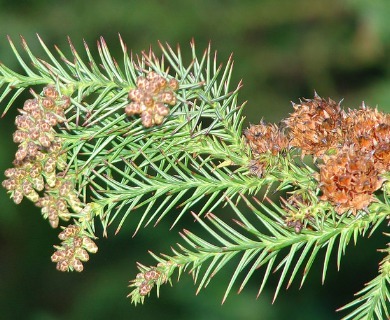Japanese Cedar
Cryptomeria japonica
Cypress family (Cupressaceae)
Post-Cook introduction
Introduced aromatic tree with small awl-shaped or needle-like leaves. In Hawaii, it grows to 80 ft (24 ) in height and 1.5 ft (0.5 ) in diameter. cone- or pyramid-shaped or narrow. Trunk straight, tapering from enlarged base. Branches spreading horizontally. Bark reddish brown, with long fissures, smoothish to slightly shaggy, fibrous, peeling off in long shreds. Inner bark is light pink within red-brown outer layer, resinous. Twigs very slender, dull green, hairless, spreading or drooping, mostly shedding with leaves after a few years. Buds minute.

©2009 Forest And Kim Starr
Males cones in clusters of 20 or more at leaf bases near ends of twigs, oblong, 1⁄4–3⁄8 inch (6–10 ) long, orange or reddish. Female cones on the same tree, single on short leafy stalks, rounded, 1⁄2–3⁄4 inch (13-19 ) in diameter, dull brown, opening at maturity the first year, but remaining attached for many many years. Cone- 20–30, outer surface flattened and angled with 3–5 spine-like points at top and another curved down from center.
Seeds 2–5 at base of cone- slightly three-angled, less than 1⁄4 inch (6 ) long, dark brown, with narrow wings on edges. Sometimes a leafy twig grows from the of the slightly pointed cone.
The wood is soft, lightweight, aromatic, easily worked, and durable. The sapwood is whitish or yellow, and heartwood reddish brown. Wood grown in Hawaii has a specific gravity of 0.41 and thus should have strength properties similar to western redcedar (Thuja plicata). One of the most important timbers of Japan, it is used for construction, paneling, furniture, and boxes there. In Hawaii, where there are 2.5 million board feet, the wood has so far been used only for fence posts.
Cryptomeria is the national tree of Japan, where it is important in forestry plantations, and is widely planted as a tree and ornamental, and is found around temples. Alone in its this species has many horticultural varieties.
Forest plantations have been established in moist middle altitudes of Hawaii, mostly at 2500–6000 (762–1829 ) on Kauai, Maui, and the island of Hawaii. Trees may be seen at Kokee on Kauai, on the Kula and Waihou Spring Forest Reserves on Maui, and along the old Volcano Road at Volcano Village, Hawaii. The best stand in the state of Hawaii is on the land of Papa in South Kona, where the trees were planted in the late 1880s. About 500,000 trees were planted by the Division of Forestry at various locations on the Forest Reserves between 1910 and 1960. Grown also as an ornamental and windbreak.
Champion
Height 105 ft (32.0 ), c.b.h. 8.8 ft (2.7 ), spread 18 ft (5.5 ). Hoomau Ranch, Honomolino, Hawaii (1968).
Range
Japan and China. Widely planted in warm temperate regions, including Europe, eastern United States north along the coast to New York City and Boston, and in Pacific States.
Other common names
Sugi, cryptomeria